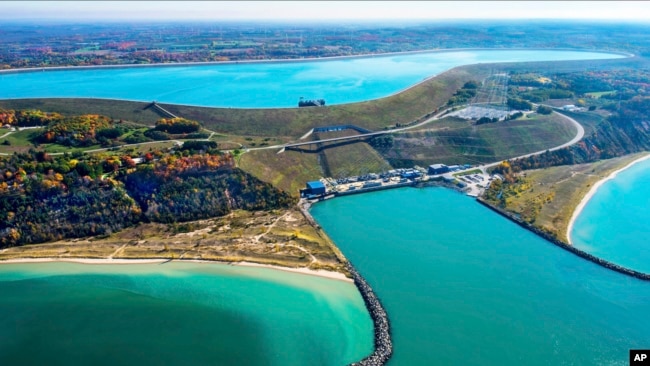揚水発電、その可能性
我が国は、その地形から揚水発電は必要不可欠なものとなっています。
アメリカとても例外ではありません。
蓄エネルギーシステムは、いまやLiイオン2次電池(LIB)以外のシステムへも広がり、100年前からある伝統的な揚水発電システムの再評価に伴い、猛烈な建設ラッシュが始まりました。特に導入規模が大きいのが、中国、米国、オーストラリアやインドです。近い将来、世界全体で2019年以前の約2.5倍の出力規模になるとのことです。
今日もVOAで英語を学び、将来のエネルギーを考えましょう!!
揚水発電:世界最大の蓄電池?(和訳)
Pumped Storage: The World’s Largest Battery?
April 27, 2022
米国の水力発電業界では、太陽や風がないときに電力を確保するという再生可能エネルギーをめぐる問題に対する最良の答えが揚水発電だと考えられています。
しかし、揚水発電の将来は不透明です。専門家が揚水発電の需要の伸びを予測しても、業界の成長は鈍化しているのです。
揚水発電とは?
揚水発電とは、水を下の貯水池から上の貯水池に送り、タービンと呼ばれる大きな機械を通して下へ放流する方法です。
揚水発電の歴史は古く、1930年代前半に始まりました。しかし、ほとんどのシステムは、原子力発電所からの電力を保持するために何年も後に建設されました。
大量のエネルギーを蓄えることができるため、支持者はこれらのシステムを”世界最大のバッテリー”と呼んでいます。
米国には43の揚水発電施設があり、約22ギガワットを貯蔵しています。しかし、1995年以降に建設された小規模な施設は1つだけで、 —90以上計画されている施設のうち、経済的、法的、実用的な問題を克服し、長期間の遅延を強いられる施設がどれだけあるかは未知数です。
3つのプロジェクトが連邦エネルギー規制委員会(FERC)から許可を得ていますが、いずれも建設には至っていません。
一方、ヨーロッパ、インド、中国、日本を中心に、世界では60以上の施設が建設されています。
全米水力発電協会のマルコム・ウルフ会長は、1月に行われた上院エネルギー・天然資源委員会の公聴会で不満を述べました。公式の承認には、あまりにも多くの機関が関わっていると彼は言います。
「そのプロセスは異常だ。」と彼は言います。
揚水発電への批判
環境保護主義者は揚水発電のダムによって形成される貯水池を懸念しています。このようなダムは、魚の動きを妨げ、水質を悪化させ、温室効果ガスであるメタンを放出する可能性があります。また、ほとんどの発電所は継続的に川から水を引いています。
しかし、最近の設計では、地表または地下から水を供給し、その水を貯水池間で繰り返し循環させる”クローズドループ”システムが採用されています。水は蒸発や水漏れを補うためだけに追加されます。
環境保護団体を代表するHydropower Reform Coalitionは、”非常に限られた状況”であればこのようなプロジェクトを支持する可能性があると述べています。
しかし、ワシントン州のゴールデンデール・エネルギー貯蔵プロジェクトなど、抵抗を受けるものもあります。このプロジェクトは、丘の反対側にある2つの24.3ヘクタールの貯水池の間に水を送るというものです。
このプロジェクトを主導するライ・デベロップメント社によると、この施設では50万戸近い家庭に最大12時間電力を供給することができると言います。FERCの承認を得て、2028年に稼働する予定ですが、ワシントン州の許可がまだ必要です。
環境保護団体は湿地帯や野生生物への被害を懸念し、アメリカ先住民族はこのプロジェクトが聖域を横切ると言っています。
American Riversのアソシエイト・ディレクター、ブリジット・モラン氏は「この技術を稼動させるために何を犠牲にするつもりなのか」と語っています。
開発者は、このプロジェクトには汚染された貯水池の下流域の浄化も含まれると言っています。
将来
貯蔵エネルギーの市場が拡大するにつれ、新しい技術も登場しています。
例えば、テキサス州に本社を置くクイドネット・エナジー社は、地下に水を汲み上げ、岩盤の中に保持し、タービンに放出して発電する揚水発電システムを開発しました。
今のところ、8〜16時間発電できる揚水発電所のライバルは電池です。リチウムイオン電池の寿命は通常4間ですが、より長寿命のものが開発されています。
「8時間の電池が揚水発電所より安くなる時代が来るのでしょうか?10億ドルの問題です。」と、国立再生可能エネルギー研究所の専門家、ポール・デンホルム氏は言います。
2016年のエネルギー省の報告書では、米国のネットワークは36ギガワットの新しい揚水発電容量を持つことができるとされています。
水力発電協会の市場担当副社長であるカメロン・シリング氏は、「揚水発電が全てであるとは考えていないが、我々の貯蔵の将来にとって不可欠な部分である」と述べています。「これなくしてシステムの脱炭素化はあり得ない。」
Pumped Storage: The World’s Largest Battery?
This undated photo provided by Consumers Energy shows an aerial view of the Ludington Pumped Storage Plant near Ludington, Mich. Advocates of pumped storage call such facilities the "world's largest batteries." (AP Photo/Consumers Energy)
The United States hydropower industry considers pumped storage the best answer to a question surrounding renewable energy: where to get power when the sun is not shining or the wind is not blowing.
But pumped storage faces an unclear future. Even though experts predict growing demand for power storage, the industry’s growth has slowed.
What is pumped storage?
Pumped storage is when water is sent from a lower reservoir to an upper one, then released downhill through large machines known as turbines.
Pumped storage dates from the early 1930s. But most systems were built many years later to hold electricity from nuclear plants.
Supporters call these systems “the world’s largest batteries” because they hold large amounts of energy.
The U.S. has 43 pumped storage facilities that hold about 22 gigawatts. Yet, just one small operation has been added since 1995 — and it is unknown how many of more than 90 planned facilities can overcome economic, legal and practical issues that force long delays.
Three projects have received permission from the Federal Energy Regulatory Commission (FERC), but none are being built.
In contrast, more than 60 are being built worldwide, mostly in Europe, India, China and Japan.
Malcolm Woolf, president of the National Hydropower Association, complained during a January hearing of the Senate Energy and Natural Resources Committee. He said official approval involves too many agencies.
“The … process is crazy,” he said.
Criticisms of pumped storage
Environmentalists are worried about pumped storage because reservoirs typically are formed by hydropower dams. Such dams can block fish movements, damage water quality and release methane, a greenhouse gas. Also, most plants continuously draw water from rivers.
But recent designs include “closed-loop” systems that use a surface or underground supply, then repeatedly cycle that water between reservoirs. Water would be added only to make up for evaporation or leaks.
The Hydropower Reform Coalition, representing environmental groups, says it might support such projects under “very limited circumstances.”
Yet some are drawing resistance, including the Goldendale Energy Storage Project in Washington state. It would send water between two 24.3-hectare reservoirs on opposite sides of a hill.
The facility could power nearly 500,000 homes for up to 12 hours, according to Rye Development, which is leading the project. It is seeking FERC approval and is scheduled to go online in 2028 but still needs permission from Washington state.
Environmental groups fear harm to wetlands and wildlife, while Native American tribes say the project would cross onto a sacred area.
“What are we willing to sacrifice to get this technology online?” said Bridget Moran, an associate director of American Rivers.
Developers say the project would include cleanup of the polluted, lower reservoir area.
Future
As the market for stored energy grows, new technologies are appearing.
Texas-based Quidnet Energy, for example, has developed a pumped storage system that forces water underground, holds it amid rock layers and releases it to power turbines.
For now, batteries are the leading competitor to pumped storage plants, which can generate power for eight to 16 hours. Lithium-ion batteries usually last up to four hours, but longer-lasting ones are in the works.
“Are we going to get to the point where an eight-hour battery is cheaper than a pumped storage plant? That’s the billion-dollar question,” said Paul Denholm, an expert with the National Renewable Energy Laboratory.
A 2016 Energy Department report said the U.S. network could have 36 gigawatts of new pumped storage capacity.
“We don’t think pumped storage is the be-all, end-all but it’s a vital part of our storage future,” said Cameron Schilling, vice president of markets for the hydropower association. “You can’t decarbonize the system without it.”
Words in This Story
hydropower – n. of or relating to production of electricity by waterpower
reservoir – n. an artificial lake where water is collected and kept for use
evaporation – n. a change in state from a liquid to a vapor
vital – adj. very important
decarbonize – v. to remove carbon from
アメリカ揚水発電所一覧地図と容量
